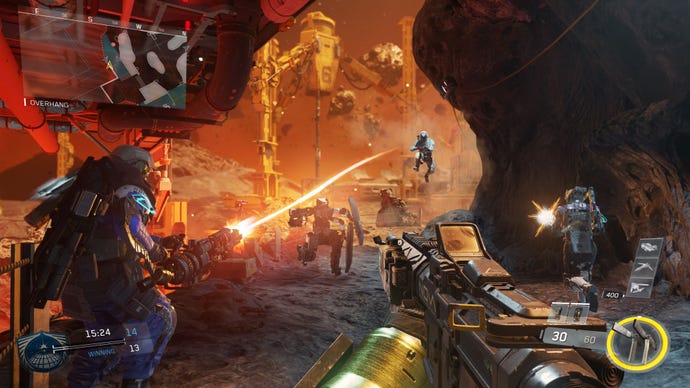Infinite Warfare is the most underrated Call of Duty campaign ever made
Men from Mars are invading Planet Earth. They’re human, not that it matters - distance has made them different.
They started as colonists, mining the red world for the resources no longer available at home. Soon enough, the harsh environment shaped a spartan culture, and a sense of Darwinian superiority. New generations were born off-world, to whom our strange blue orb was cold and unfamiliar, a cautionary tale of excess. War followed, and new borders were drawn between the stars. We made our own aliens, right in the backyard of our solar system.
That’s the premise of Call of Duty: Infinite Warfare - a science fiction story with, if not its boots on the ground, then at least a footprint in our reality. Plenty of Call of Duty fans have never heard it. Much of that audience made up its mind long before the game came out, making its debut trailer the most disliked gaming video on YouTube.
It’s impossible to know how many people actually played Infinite Warfare, since three of its editions were packaged with Modern Warfare Remastered. The bundle might have ensured sales for Activision, but it also meant that if players were going to play just one of the two COD campaigns they’d purchased, it would be the nostalgic classic rather than the space game that had riled sceptics.
It’s an injustice that has seen Infinite Warfare go oddly under the radar. Did you know, for instance, that Kit Harington is its villain? Kit Harington, wearing a domed glass helmet that makes him look like an egg with Jon Snow’s head painted on it. Kit Harington, ordering robots to stamp on your squad’s heads in order to save bullets. Kit Harington, leading a devastating terrorist attack on Geneva.
That latter sequence is Infinite Warfare’s opening salvo - proof the new Infinity Ward can do suspense and spectacle on a par with the old. Set during an annual display of a united Earth’s fleet, it’s loaded with dread as your colleagues in the United Nations Space Alliance repeatedly reference tension with Mars. Minutes later, it’s Pearl Harbor. Amid the noise and chaos, a 600 metre warship plunges helplessly into the earth it was built to defend, enveloping a whole street in wind and debris. In the eerie aftermath, you pass dust-covered civilians stumbling silently through the darkness, the only screams coming from the car alarms. It’s a scene horribly evocative of recent real-world events, and gives an indicator of how Infinity Ward might tackle the new Modern Warfare’s Piccadilly Circus attack.
Then, of course, you go after Kit, taking your fighter ship up through the atmosphere to rout the enemy in a Lucas-esque dogfight, before landing on your carrier in orbit around Earth. It’s all scripted, but seamless. Space feels close, no more than 30 seconds away, and it’s hard to overstate the impact of that proximity on a spectacle shooter. It leaves Infinite Warfare’s path through the campaign unpredictable and breathless.
The Olympus Mons, Kit’s unfathomably huge flagship built like a Doom gauss cannon, haunts you throughout the story. At times it appears in the atmosphere of a moon when you’re on the ground, flattening you against the surface. At others it warps in unexpectedly to pull up alongside your tiny fighter ship, dwarfing you in its shadow. It is like some great leviathan, the Moby Dick to your Ahab.
Space transforms not just COD’s pacing but its shooting, too - for the first time in an age. In the opening phase of a ship boarding, you’re often left adrift in zero-g. If there’s no good cover on a strip of debris, you’re free to grapple onto the underside of a rock instead, twisting your perspective so that up is down. Once on board, you can apply pockets of anti-grav to the ship via grenades, lifting your enemies out from behind cover, where you can take easy shots at them like game birds. Afterwards, they hang limply in a blue haze before crashing back down to the deck.
My favourite tool on Infinite Warfare’s belt, though, is the bot hijacker. COD campaigns have always hopped between different perspectives; momentarily jumping into the body of an AI combatant to wreak havoc feels like the perfect sci-fi twist.
You’ve got your own robot friend, too, named Ethan. He’s designed to fight as efficiently as possible with the Marines, which involves earning their trust, and so he’s programmed with bants. He’s paired particularly well with the bristly Marine commander played by Homeland’s David Harewood, a rare black British voice in video games.
The cast rub up against each other on the Retribution, the carrier ship you run as a hub between levels. It’s a bold structural change for COD that allows for side missions and, bar the odd repeated room, they work a treat. Plus, a mo-capped Lewis Hamilton works as an engineer in your crew, wearing a baseball cap and moaning about “fried gaskets”. It’s triple-A money blown the best way. Conor McGregor is in it as well, for some reason.
Infinite Warfare’s biggest flaw, if you can call it that, is just how closely it resembles Titanfall. With a rocket-powered double jump, vertical level design, and even a rudimentary wall-run, the two sometimes feel identical. In fact the movement is only distinguished by the relative sluggishness of Infinite Warfare, weighed down by those COD boots. The insistence on a cursory nod to reality keeps dragging the series back down to earth.
Infinity Ward needn’t have bothered grounding Infinite Warfare at all. COD diehards didn’t show up anyway, and so the series returned to familiar battles. But I’d recommend fighting fascists on Mars instead, where warfare is a little less predictable.




